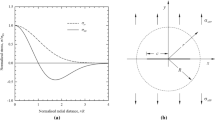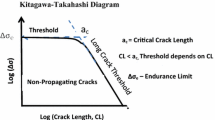Abstract
Progressive radial cracking of a clamped plate subjected to crack-face closure is studied. The material behavior is assumed to be elastic-brittle. The cracks are assumed to be relatively long in the sense that the three-dimensional contact problem can be described via a statically equivalent two-dimensional idealization. The number of cracks is supposed large enough to permit a quasi-continuum approach rather than one involving the discussion of discrete sectors. The formulation incorporates the action of both bending and stretching as well as closure effects of the radial crack face contact. Fracture mechanics is used to explore the load-carrying capacity and the importance of the role of the crack-surface-interaction. For a given crack radius, the closure contact width is assumed to be constant. Under this condition, a closed-form solution is obtained for the case of a finite clamped plate subjected to a concentrated force. Crack growth stability considerations predict that the system of radial cracks will initiate and grow unstably over a significant portion of the plate radius. The closure stress distribution is determined exactly in the case of narrow contact widths and approximately otherwise.
Similar content being viewed by others
References
J.P. Dempsey and Z.G. Zhao, Journal of the Mechanics and Physics of Solids 41 (1993) 487–506
D.S. Sodhi, ASCE Journal of Cold Regions Engineering 9 (1995) 4–22
D.S. Sodhi, Ice Mechanics-1995, J.P. Dempsey and Y.S. Rajapakse (eds.), ASME AMD.
L.I. Slepyan, Mechanics of Solids (translation of Izvestiya AN SSSR: Mekhanika Tverdoga Tela) 25 (1990) 155–161
Y.N. Li and Z.P. Bazant, ASCE Journal of Engineering Mechanics 120 (1994) 1481–1498.
D.P. Jones and J.L. Swedlow, International Journal of Fracture 11 (1975) 897–914.
F.S. Heming, International Journal of Fracture 16 (1980) 289–304.
K. Hellan, International Journal of Fracture 26 (1984) 17–30.
J.R. Rice and N. Levy, Journal of Applied Mechanics 39 (1972) 185–194.
J. Dundurs, in Mechanics of Contact between Deformable Bodies, A.D. de Pater and J.J. Kalker (eds.) Delft University Press (1975) 54–66.
S. Timoshenko and S. Woinowsky-Krieger, in Theory of Plates and Shells, Second edn., McGraw-Hill (1959).
X.-R. Wu and A.J. Carlsson, Weight Functions and Stress Intensity Factor Solutions, Pergamon Press (1991).
H. Tada, P.C. Paris, and G.R. Irwin, The Stress Analysis of Cracks Handbook. Del Research Group, St. Louis, (1985).
A.C. Kaya and F. Erdogan, Quarterly of Applied Mathematics 45 (1987) 105–122.
J.P. Dempsey, R.M. Adamson and S.J. DeFranco, International Journal of Fracture 69 (1995) 281–294.
L.A. Kipnis, Journal of Applied Mathematics and Mechanics (translation of PMM) 43 (1979) 164–170.
TableCurve, Jandel Scientific, San Rafael, CA (1992).
C. Gurney and J. Hunt, Proceedings of the Royal Society A361 (1967) 254–263.
S.J. DeFranco and J.P. Dempsey, Journal of Glaciology 40 (1994) 451–462.
Author information
Authors and Affiliations
Rights and permissions
About this article
Cite this article
Dempsey, J.P., Slepyan, L.I. & Shekhtman, I.I. Radial cracking with closure. Int J Fract 73, 233–261 (1995). https://doi.org/10.1007/BF00037646
Received:
Accepted:
Issue Date:
DOI: https://doi.org/10.1007/BF00037646




